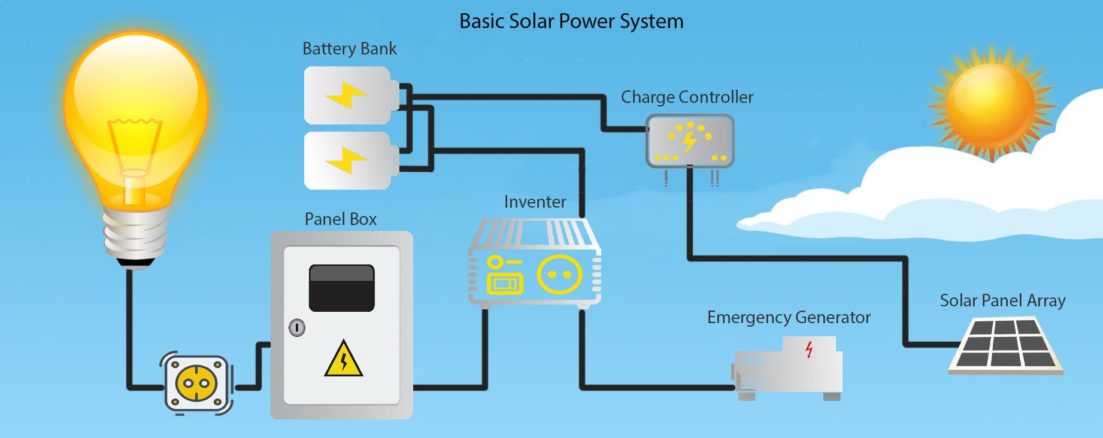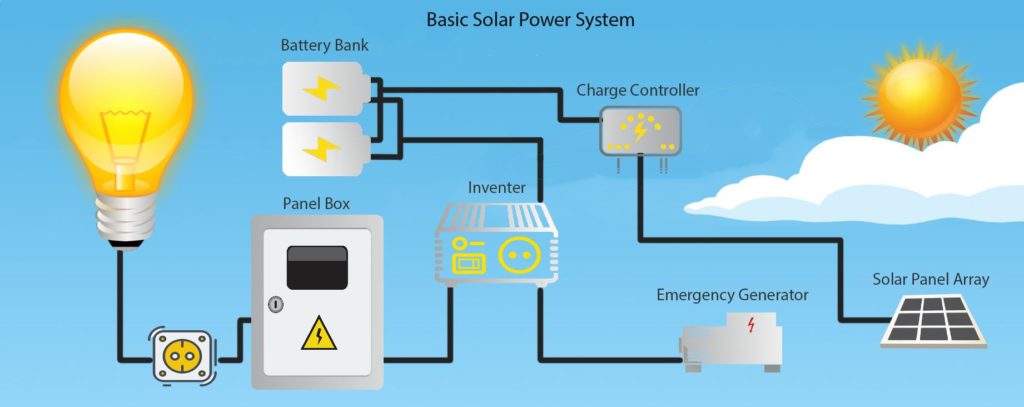This Solar System Buyer’s Guide aims to help you understand how the system works to make sure that you are taking the right informed decisions in your purchases.
Solar system is touted as the best alternative energy source that can save households more conventional electricity bill. Solar panels are the most important components of a solar system. To take advantage of solar system, you need to understand how it works, how to install panels, and decipher many terminologies akin to solar system.
Frequently asked questions about solar power systems
How do solar systems work?
The solar system basically converts the sun’s radiation into electricity by using the photovoltaic panels. The ultraviolet wavelengths from the sun are strong enough to activate electrons which are directed to the inverter to transform the direct current into an alternating current used by household appliances. This power from the sun can be used for a variety of purposes such as lighting your home, cooking, charging batteries and many more.
The power can be used directly or stored in batteries for later consumption when there is no sun. This helps particularly in winter seasons. All you needed for the efficiency of the solar system are the photo-voltaic panels, rack to mount the panels, an inverter and wires to connect the panels together.

200 Watt- Off-Grid Solar System Info-graphics
How to install solar panels?
There is a myriad of factors to consider when installing solar panels. To start with, you need to have a rounded knowledge and technical know-how to effectively install these panels. Any faulty or inexperienced installation can render the system useless. Alternatively, you can contract professionals to do the installation for you.
When installing the panels, the roof must be sturdy so it doesn’t sink or bend. The solar panels should be installed in direct exposure with sunlight on any part of your roof. Depending on the number of panels to install, calculate the dimensions of the roof as an assurance that the panels can fit properly. Also noteworthy are the future plans if you want to add more solar panels to accommodate energy demands. Ensure that the roof has no imminent developments in the neighborhood that can expose the panels to shades because that can impede or tamper with the output of your solar panels.
Collection of equipment such as mounting brackets is important especially for sloped roofs. The flat roofs can accommodate the rails where you can mount these panels. The angle at which you mount these solar panels should be consistent to ensure the same voltage output. Other components include the conduit and insulated wires. The process shouldn’t be difficult if you are technology savvy homeowner. Otherwise, if the entire process becomes cumbersome, a local professional can help you.
Which solar panel is best?
Polycrystalline vs. Monocrystalline vs. Thin film
Polycrystalline or multi-crystalline solar panels entails multiple silicon atoms used in their production. To produce poly-crystalline, the manufacture melts the raw silicon and then pours it into a square mold then cut it into numerous pieces.
The advantage of poly-crystalline solar panel is that is cheaper and requires little silicon than the single-crystalline (mono-crystalline) solar panels. They tolerate heat better than mono-crystalline. However, the downside is that these solar panels have a low efficiency that ranges from 13 to 16% due to lower silicon atoms.
Monocrystalline, on the other hand, involves single silicon of high purity used to optimize the performance of solar panels. These panels are produced from cylindrical-shaped silicon ingots. While mono-crystalline solar panels have high energy efficiency, they are the most expensive. Moreover, they last longer.
Thin film solar panels involve a thin layer of photo-voltaic materials applied on a substrate. The naming of these panels depends on the photo-voltaic material used. For instance, there could be amorphous silicon, cadmium telluride, copper indium gallium selenide and organic photo-voltaic cells. These panels can be cheaper but have low efficiency compared to the above-mentioned. The good side is that thin film panels survive shades and high temperatures.
[highlight]Thin film panels can be good for budget-constraint households but not intensive applications. mono-crystalline panels, due to their high efficiency, can be ideal for commercial buildings while poly-crystalline are suitable for homes. Nonetheless, the choice of any typical solar panel rests with the owner alongside the budget.[/highlight]How to choose the right installer?
As we have highlighted already, it is better to have a professional installer rather than tampering with the installation and eventually rendering the solar system ineffective. However, you should be vigilant of the inexperienced, self-proclaimed installers prevalent online. First, make sure the installer is certified according to your country’s rules; has reputation and track record; understands your energy needs, and can give a great advice on how to optimize your solar system performance. Also, it is important to request quotes from at least 3 installers and then compare them.
How many solar panels are needed to power a house?
The number of solar panels needed in a house will be dependent on several factors. For instance, for an existing house, you can calculate the current electricity consumption and base your estimated number of that. For newly built houses, that previous consumption will not help. Instead, you can use a square footage for your calcualtions.
You can, for example, calculate based on 2 watts per square foot, which will give 2000 watts for a 1000 square footage. Typically, this would require around 6 to 9 solar panels depending on the panel chosen. To stay on the safe side, find a professional installer to help you with these calculations.
Normally, a solar panel can produce between 250 and 325 watts. They are rated using the direct current power.
Do you need to clean your solar panels?
The angles at which solar panels are mounted make it easy for a self-cleaning process. However, there could still be some stains of dust or other debris. It is important to occasionally wipe them to avoid any slow performance because dust can tamper with the production of electricity.
How long do solar panels last for?
Solar panels can last for up to 30 years. Monocrystalline panels last longer than the polycrystalline panels, which in turn last longer than the thin-film panels. The national Renewable Energy Laboratory has conducted the study that indicated that most solar panels lose about 0.5% of efficiency yearly. Even though the solar panel can last long, the inverter can last from 10 to 15 years. It will need a replacement.
How long do solar panels take to pay for themselves?
The solar panel installation in US can cost around $16000 on average. With the tax credits included, it can even cost less, say around $4000. That said, it can take from 7 years to 20 years until the solar panel covers the costs using the savings achieved.
Can you use artificial light for solar panels?
Solar panels work on sunlight to produce reliable electricity that can power a wide array of appliances. Although they rely on light, not all lights can activate the electrons and transform into electricity. So, an artificial light will not be successful on solar panels compared to the ultraviolet wavelengths. Artificial light sources can at least work indoors to power small gadgets such as watches using the solar panels.
How Much Does a 5kW Solar System Cost in 2018?
In the United States, the average cost of solar system is around $3.13 per watt. So, it will be about $15,700 for a 5kW solar system. The amount will be reduced after the tax credits.
What are snow, rain, dust effects?
During clouds and rain, the solar panel can still work but not to its optimal performance. The rain, on the other hand, will help in cleaning the panel from dust. Snow has a negative effect on the performance of solar panels, and so is the dust unless cleared off. But the dust effect is not too bad because the panel can still work but at a low rate of production.
Do solar panels work in the shade?
Yes, there will be an output of electricity at a compromised rate. Thin-film solar panels can work better in shades compared to mono-crystalline and poly-crystalline panels.
Can we use solar energy without batteries?
Yes, we can. The batteries are only necessary if you want to save electricity for later use. The solar panel can still work without the batteries.
Can you hook up a solar panel directly to a battery?
Yes, you can hook it up directly, especially the small panels with output 5 watts at 12 volts. You can even charge the batteries but hooking them up directly.
How long does it take for a solar panel to charge a battery?
Use the equation that follows:
Charge time = load put on the battery in Amp hours multiplied by 1.15 which is the 115% of capacity, divided by the charge rate which is equal to Watts/Volts. Other factors such as the inverter and charge controller can also have an impact on the charge time. As an example, a 245-Watt panel can charge a 12-Volt battery in 7 hours.
Do solar panels need a lot of maintenance?
No, they do not. There are no moving parts, so it will not demand lots of maintenance in a year. You can occasionally clean it up to optimize its output.
What is the warranty period of solar panels?
The performance of the solar panel can last up to 25 years while the equipment lasts for about 10 to 15 years. The warranty can differ from one solar panel to the other type.



Comments
The best solar panel’s information I have ever read. Clear and simple.
Thank you